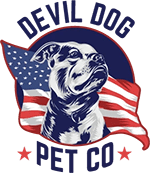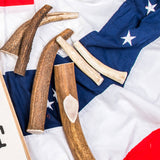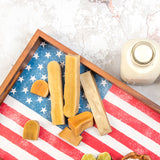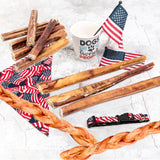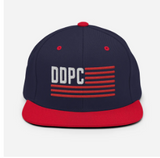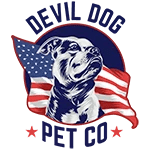The Ultimate Guide to Dog Bones: What Every Owner Should Know
Let's face it—nothing beats the joy on your dog's face when you present them with a fresh bone to gnaw on. As a Marine veteran who's spent countless hours watching our dog Dexter work through various chews, I've learned that not all dog bones are created equal. Some provide hours of enrichment while others can crack teeth or cause digestive nightmares.
The term "dog bones" covers everything from natural animal bones to synthetic chews designed to mimic them. Making the right choice isn't just about keeping your pup entertained—it's about their dental health, safety, and overall wellbeing.
After years of testing products and gathering feedback from our community of extreme dog leaders, I've compiled this definitive guide to help you navigate the sometimes confusing world of dog bones.
Natural Bones for Dogs: Benefits and Risks

When most people think about dog bones, they picture those large, raw beef bones from the butcher counter. There's something primal about watching your dog tear into a natural bone—it satisfies their instinctual need to chew while providing substantial dental benefits.
The Case for Real Bones for Dogs
Natural bones for dogs offer serious advantages when selected properly. The mechanical action of gnawing on a hard surface helps scrape away plaque and tartar, essentially giving your dog a dental workout. Many veterinarians agree that regular chewing can reduce the need for professional cleanings.
Beyond dental health, natural dog bones provide mental stimulation that can prevent destructive behaviors. When Dexter has a proper bone to focus on, he's not eyeing up my furniture or shoes. The sustained concentration required to work on a good bone also releases endorphins, creating a calming effect that can help with anxiety.
Cow Bones for Dogs: A Popular But Controversial Choice
Beef bones for dogs, particularly cow bones, are widely available and relatively inexpensive. Many owners swear by large cow femur bones (often called "soup bones") because they're dense, long-lasting, and contain marrow that dogs find irresistible.
However, these big bones for dogs come with significant risks. The hard exterior of cow bones can fracture teeth—especially in powerful chewers. I've seen too many customers share horror stories about $1,500 canine dental bills after their dog cracked a molar on a beef bone.
Additionally, cow bones for dogs can splinter, creating sharp fragments that might cause intestinal punctures or blockages. This risk increases as the bone dries out after several chewing sessions.
Safer Alternatives to Traditional Dog Bones
The good news is that you don't have to choose between your dog's safety and their need to chew. The market for dog bones has evolved dramatically, offering options that provide the benefits without the dangers.
Natural Dog Bones: The Antler Alternative
Elk antlers represent one of the best natural bones for dogs who need serious chewing time. Unlike traditional bones, premium-grade antlers are naturally shed (not harvested from animals), making them an ethical and sustainable option.
What makes antlers superior to cow bones? They rarely splinter, contain beneficial minerals like calcium and phosphorus, and typically last 3-5 weeks for moderate chewers. For large dogs or power chewers, sizing up to a Monster or Beast-sized antler provides a safe outlet for those powerful jaws.
Explore our premium elk antler dog chews: Premium Elk Antler Dog Chews
Healthy Dog Bones: Himalayan Yak Chews
If you're looking for something between the hardness of an antler and the appeal of an edible treat, Himalayan yak cheese chews offer a compelling middle ground. These all-natural dog bones are made from yak and cow milk, salt, and lime juice—a simple recipe that yields an incredibly hard, long-lasting chew.
What sets these apart from other organic dog bones is their digestibility. As your dog works the end of the chew, their saliva softens small bits that break off, making them easy to digest. Unlike rawhide (which I never recommend), these healthy chew bones for dogs don't swell in the stomach or create blockage risks.
Check out our selection of yak cheese Himalayan dog chews: Yak Cheese Himalayan Dog Chews
Beef Bone Alternatives: Bully Sticks
For dogs who crave that meaty flavor of a beef bone but need a safer option, bully sticks provide an excellent alternative. These natural bones for dogs to chew are made from 100% beef pizzle, slow-baked into a digestible, protein-rich treat.
While not technically "bones," bully sticks satisfy the same urge while being fully digestible. They're particularly good for puppies transitioning to adult chews or senior dogs whose teeth can't handle harder options. For large dogs, jumbo or braided bully sticks offer more challenge and longevity.
Choosing the Best Bones for Large Dogs
Big dogs present special challenges when it comes to chew selection. Their powerful jaws can make quick work of options that might last weeks for smaller breeds, yet they often need more substantial chewing outlets.
Safe Dog Bones for Large Dogs
When selecting chew bones for large dogs, size matters tremendously. A bone that's too small becomes a choking hazard or swallowing risk. The general rule: choose a bone longer than your dog's muzzle and thick enough that it can't fit between their back molars.
For power chewers, look for huge dog bones like Monster or Beast-sized whole antlers. These substantial pieces stand up to serious pressure while providing weeks of entertainment. The dense outer wall forces slow grinding rather than aggressive biting, protecting teeth while extending the chew's lifespan.
Consider these great options for large dogs:
Best Bones for Big Dogs: Rotation Strategy
The most successful approach I've found for keeping large dogs satisfied is implementing a rotation strategy. Rather than offering the same chew day after day, alternate between different types:
- Whole antlers for marathon chewing sessions
- Split antlers when you want to provide instant gratification
- Jumbo bully sticks for protein-rich treats
- Monster yak chews for a different texture and flavor profile
This variety prevents boredom while addressing different chewing needs. It also gives each chew time to "rest," potentially extending its lifespan.
Best Big Bones for Dogs: Supervision Is Key
Even with the safest natural bones for dogs, supervision remains essential—especially during the first few sessions with a new chew type. Watch how your dog approaches the bone. Are they trying to swallow large pieces? Are they biting down with full force (risking tooth damage) or grinding appropriately?
These observations help you refine your selection process and intervene before problems develop. Remember, no chew is 100% risk-free for every dog—knowing your individual dog's chewing style is crucial for safety.
The Science Behind Effective Dog Bones

When our dog Dexter discovered antler chews, his destructive habits virtually disappeared overnight. This wasn't just luck—there's solid behavioral science behind why proper chew bones transform dog behavior. The right bone satisfies multiple instinctual needs simultaneously, creating what trainers call a "high-value enrichment activity."
Why Bones for Dogs to Chew Are Essential
Dogs need to chew. It's not a bad habit—it's hardwired into their DNA. Wild canids spend hours gnawing on bones to extract nutrients, exercise jaw muscles, and clean their teeth. When we deny domestic dogs this outlet, we're fighting biology. A frustrated chewer without appropriate bones for dogs to chew on will inevitably find alternatives: your shoes, furniture, or baseboards.
Proper chewing also triggers endorphin release—nature's stress reliever. This explains why dogs with appropriate chew bones often show reduced anxiety, less destructive behavior, and improved focus during training. The military K-9 handlers I served with understood this principle well, always ensuring working dogs had appropriate chew time between missions.
All-Natural Dog Bones vs. Synthetic Options
The market is flooded with neon-colored synthetic "bones," but these often miss what makes natural bones for dogs so effective. All-natural dog bones provide varied texture, genuine taste, and appropriate resistance that plastic simply can't replicate. Most importantly, natural options like antlers, yak chews, and bully sticks wear down gradually rather than breaking into sharp pieces.
While some veterinarians recommend synthetic options, many power chewers destroy these quickly, potentially ingesting plastic fragments. I've seen dogs demolish "indestructible" synthetic bones in minutes, while a quality natural bone might last weeks. That said, not all natural options are created equal—cow femurs can crack teeth, while properly sized antlers distribute pressure more safely.
Organic Dog Bones: What to Look For
The term "organic" gets thrown around loosely in pet products. When evaluating organic bones for dogs, look beyond the marketing to understand exactly what you're buying. True organic dog bones should come from animals raised without antibiotics, hormones, or pesticide-treated feed.
Sourcing Matters: Where Your Dog's Bones Come From
Ethical sourcing isn't just a feel-good checkbox—it directly impacts safety. Bones from industrially raised animals often contain more hormones and medications. When selecting all-natural bones for dogs, ask these questions:
- Are these sourced from free-range or pasture-raised animals?
- For antlers, are they naturally shed or harvested from deer farms?
- Does the company test for contaminants and bacteria?
- Can they trace their supply chain completely?
At Devil Dog, we source our elk antlers exclusively from naturally shed Rocky Mountain elk. Local shed hunters hike the backcountry each spring collecting these renewable resources, creating zero harm to wildlife. Similarly, our bully sticks come from grass-fed, free-range cattle—better for the environment and safer for your dog.
Processing Methods: The Hidden Factor
Even the best natural bones for dogs can become problematic depending on how they're processed. Many commercial cow bones for dogs undergo harsh chemical treatments including bleaching, which strips nutrients and creates brittleness. Some manufacturers use formaldehyde as a preservative—a practice we find absolutely unacceptable.
Quality processors use heat, smoke, or air-drying methods that preserve the bone's integrity while ensuring safety. Our yak chews, for example, are crafted in Nepal using traditional methods—milk curds pressed, smoked, and sun-dried at high altitude, with no chemicals whatsoever.
Bones for Different Dog Life Stages
Your dog's age significantly impacts which bones are appropriate. What works for an adult dog might damage a puppy's developing teeth or be too challenging for a senior's worn dentition.
Chew Bones for Puppies
Puppies have specific needs when it comes to chewing. Their baby teeth and developing jaws require gentler options, but their teething discomfort drives intense chewing urges. For puppies under 5 months, we recommend:
- Standard bully sticks (supervised, 15-minute sessions)
- Oversized split antlers (marrow exposed for easier access)
- Small yak chews (limit initial sessions to prevent digestive upset)
Once those adult molars erupt around 5-7 months, you can gradually introduce whole antlers, always monitoring how your pup approaches them. The goal is building proper chewing habits early—side gnawing rather than chomping straight down, which protects teeth throughout life.
Best Bones for Senior Dogs
- Split antlers (easier access to marrow without excessive pressure)
- Standard bully sticks (softer texture while still providing dental benefits)
- Yak chews (can be briefly soaked to slightly soften the exterior)
Monitor senior dogs closely during chew sessions, watching for signs of discomfort or fatigue. Shorter, more frequent sessions often work better than marathon chewing for older pups.
Integrating Bones into Training Routines

Beyond recreation, bones for dogs to chew on become powerful training tools when used strategically. The high value dogs place on quality chews makes them perfect for reinforcing desired behaviors.
Building Impulse Control
One of my favorite training exercises involves using natural dog bones to teach patience and impulse control. Place a high-value chew like a bully stick in plain view, but require your dog to wait for permission before taking it. This simple routine builds the foundation for broader impulse control that transfers to real-world situations.
For dogs with resource guarding tendencies, regular trading games using bones can transform this behavior. Offer a small treat in exchange for relinquishing the bone, then immediately return it. This teaches your dog that giving up resources temporarily leads to positive outcomes, not loss.
Learn more about safe and effective dog dental treats and chews at AKC's expert advice on dog dental treats safety.
Crate Training and Alone Time
Appropriate bones for dogs to chew on transform crate training from confinement to retreat. A special bone that only appears during crate time creates positive association and occupies your dog during the critical first 20-30 minutes when separation anxiety typically peaks.
When Dexter was younger, we established a routine where a fresh bully stick appeared only when we left the house. This simple pattern shifted his emotional response from "my humans are leaving" to "I get my special chew!" Within weeks, he'd voluntarily enter his crate when we grabbed our keys.
Rotation: The Secret to Maximizing Bone Benefits
Even the best natural bones for dogs lose their appeal when offered continuously. Dogs crave novelty—it's why they'll ignore expensive toys to chew cardboard. Implementing a strategic rotation between different bone types maintains interest while addressing various chewing needs.
Creating Your Bone Rotation System
Start with three different chew types: perhaps a whole antler, split antler, and bully stick. Offer one type for 2-3 days, then swap it out for another from your rotation. Store unused chews in a sealed container to preserve scent and appeal. This simple system makes each appearance feel fresh and exciting to your dog.
For maximum engagement, consider these rotation principles:
- Alternate hardness levels (hard antler, medium yak chew, softer bully)
- Switch between animal sources (elk, yak, beef) for flavor variety
- Rotate chew shapes (straight, curved, braided) to engage different teeth
- Vary sizes to change how your dog must manipulate the chew
This rotation strategy not only extends the life of your investment but provides comprehensive dental coverage by working different parts of the mouth through varied chewing actions.
Discover a wide range of veterinarian-approved dental chews at PetMD's best dental chews for dogs.
Safety First: Supervising Bone Chewing Sessions
No matter how safe the bone, supervision remains non-negotiable. When our dog Dexter first tried an elk antler, I watched him like a hawk—not hovering, but staying aware of his chewing style. This vigilance isn't paranoia; it's responsible ownership. Even premium natural bones for dogs require monitoring to prevent potential hazards.
Warning Signs to Watch For
Learn to recognize when a chewing session should end. If your dog starts chomping straight down rather than gnawing sideways on an antler, immediately redirect or end the session. This vertical biting puts enormous pressure on the molars and risks fractures. Similarly, if a bully stick or yak chew becomes small enough to swallow whole, trade it for a treat before it becomes a choking hazard.
Create a consistent safety routine: inspect bones before each use, monitor the first few minutes of every session, and check periodically throughout. This habit takes minimal effort but prevents most chew-related emergencies. When introducing new bones for dogs to chew on, schedule the first session when you can give full attention—never during a busy workday or distracted evening.
For a list of products accepted by the Veterinary Oral Health Council, see VOHC accepted products.
Setting Up a Safe Chewing Environment
Where your dog chews matters almost as much as what they chew. Designate specific chewing zones with appropriate surfaces. A washable bed, crate mat, or dedicated blanket creates a comfortable spot that also signals "chew time." This boundary training prevents dogs from dragging messy chews onto carpets or furniture.
For large dog bones like whole antlers, consider a dedicated chew mat with non-slip backing. These provide traction for leverage while protecting floors from scratches when the bone inevitably drops. Keep fresh water available during chewing sessions, as the increased saliva production can lead to thirst.
Understanding Bone Durability for Different Chewers

Not all chewers are created equal. Some dogs nibble delicately for hours; others approach bones like competitive eating contests. Matching bone durability to your dog's chewing style prevents frustration and waste.
Identifying Your Dog's Chew Style
Before investing in premium natural bones for dogs, assess your dog's unique approach to chewing. Observe them with a current chew toy and note these patterns:
- Nibblers: Gentle, methodical chewing with frequent pauses
- Sustained Chewers: Moderate pressure applied consistently over long periods
- Power Chompers: Intense pressure in short bursts, often trying to crack or split items
- Shredders: Focus on tearing rather than crushing, creating small pieces
For nibblers and sustained chewers, most natural dog bones work well. Power chompers need extremely durable options like whole elk antlers in larger sizes. Shredders do best with fibrous options like bully sticks that can be safely broken down without creating sharp fragments.
Best Big Bones for Large Dogs
- Monster or Beast whole elk antlers (7-10+ inches long)
- Jumbo beef bones for dogs (supervision required)
- Extra-thick braided bully sticks (12+ inches)
- Monster yak chews (for moderate to heavy chewers)
The key with large dog bones isn't just length but diameter. A properly sized bone should be too thick to fit between the back molars, preventing the crushing pressure that can crack teeth. When in doubt, size up—a slightly oversized bone is safer than one that's too small.
The Economic Case for Quality Dog Bones
Premium natural bones for dogs often come with higher price tags than synthetic alternatives. However, calculating the true cost requires looking beyond the initial purchase price to factor in longevity, benefits, and replacement costs.
Cost Per Chewing Hour: The Real Metric
A $5 synthetic "bone" that lasts two days provides far less value than a $25 elk antler lasting two months. Breaking this down to cost-per-hour reveals the economic advantage of durable natural options. For example:
- Typical synthetic bone: $5 ÷ 4 hours use = $1.25 per hour
- Quality elk antler: $25 ÷ 60 hours use = $0.42 per hour
- Premium bully stick: $8 ÷ 1.5 hours use = $5.33 per hour
This calculation doesn't even factor in the secondary costs of cheaper options—like replacing damaged furniture when the inadequate chew fails to satisfy your dog's needs. One destroyed couch cushion often exceeds the annual budget for quality chews.
Health Benefits: The Hidden Savings
Regular chewing on appropriate natural dog bones provides significant dental benefits that translate to real financial savings. Professional dental cleanings under anesthesia typically cost $500-1,000 annually. While chews don't eliminate the need for dental care, they can extend the intervals between professional cleanings by reducing plaque and tartar buildup.
The anxiety-reducing benefits of appropriate chewing also prevent destructive behaviors that come with significant costs—from ruined belongings to behavioral consultations. One client's dog destroyed over $2,000 in furniture before they implemented a proper chewing routine with natural bones for dogs.
Conclusion: Leading Through Proper Chew Selection
Selecting the right bones for your dog isn't just about preventing destruction—it's about fulfilling a fundamental canine need. When we provide appropriate outlets for natural behaviors, we strengthen the human-dog bond and set our companions up for success. Quality natural dog bones become tools for communication, enrichment, and behavioral management.
The most successful dog owners I've worked with understand that meeting these primal needs isn't optional—it's the foundation of balanced behavior. By investing in quality chews, establishing clear boundaries, and supervising appropriately, you're not just buying a dog bone; you're building a framework for a lifetime of positive interactions. That's what Extreme Dog Leadership is all about: taking responsibility for meeting your dog's needs so they can thrive in our human world.
Download the FREE 10-Step Dog Prep Guide
Frequently Asked Questions
What type of bones are safe for dogs?
Safe bones for dogs are typically raw, uncooked bones that are large enough to prevent choking, such as raw beef knuckle bones or raw marrow bones. These bones are less likely to splinter compared to cooked bones and can provide beneficial nutrients and dental benefits. Always supervise your dog when giving bones to ensure they chew safely.
What is dog and bone slang for?
"Dog and bone" is Cockney rhyming slang for a telephone. In this playful linguistic tradition, 'dog and bone' rhymes with 'phone,' making it a fun and informal way to refer to a telephone, especially in parts of London.
Do vets recommend giving dogs bones?
Many vets advise caution when giving dogs bones because cooked bones can splinter and cause serious injuries like choking, blockages, or internal damage. Raw bones may be safer but should still be given under supervision to avoid potential hazards. Always consult your veterinarian before introducing bones into your dog's diet.
What are the best chew bones for dogs?
The best chew bones for dogs are those that are durable, appropriately sized, and designed to be safe, such as raw meaty bones, specially made nylon or rubber chew toys, and dental chews. These options help keep dogs entertained, promote dental health, and minimize the risk of splintering or choking.
What bones should not be given to dogs?
Dogs should never be given cooked bones, especially poultry bones like chicken or turkey, as they easily splinter and can cause choking or internal injuries. Additionally, small bones that can be swallowed whole or bones that are brittle and prone to breaking should be avoided to keep your dog safe.
What is the healthiest thing for a dog to chew?
The healthiest things for a dog to chew are items that promote dental health without posing choking risks, such as specially formulated dental chews, raw meaty bones sized appropriately, and durable rubber or nylon toys. These options help reduce plaque buildup, satisfy natural chewing instincts, and keep your dog engaged safely.
